component parts of the nervous system
CNS: brain and spinal cord
PNS: nerves emanating from the brain and spinal cord to sense organs and to the periphery of the body
sensory
Sensory receptors at the ends of peripheral nerves
Generate nerve impulses transmitted to the CNS
Integrative
Translates impulses into sensation or thought
Drives motor function
Motor
Involves muscles and glands
Blood brain barrier
Cells that make up the walls of blood vessels around the
brain
allow very few molecules to pass through
Freer passage of ions, sugars, and other metabolites in
other
areas of the body
Prohibits most microorganisms from passing into the CNS
Drugs and antibiotics are difficult to introduce into the
CNS
when needed
Immune privilege of the CNS
A different or partial immune response when exposed
to
immunologic challenge
Functions of the CNS are vital for the life of an
organism and
temporary damage from a “normal”
immune response could be detrimental
nervous system defenses
bony structures, blood-brain barrier, microglial cells, and macrophages
no normal biota
Cerebrospinal fluid (CSF)
Fills the subarachnoid space
– Clear, serum like fluid
–
Provides nutrition to the CNS
– Provides a liquid cushion for the
brain and spinal cord
Meningitis
Inflammation of the meninges
Different microbes cause meningitis, and produce a
similar
constellation of syndromes
Noninfectious causes of meningitis exist as well
Serious forms of acute meningitis are caused by
bacteria.
Entrance into CNS are facilitation by or co-infection
with
respiratory viruses
Suspicion of meningitis
Lumbar puncture to obtain CSF
• Gram stain of CSF
• Culture
of CSF
• Begin treatment with broad-spectrum antibiotics with
a
shift in treatment after a diagnosis has been confirmed
Signs and Symptoms of Meningitis
Photophobia
– Headache
– Painful or stiff neck
–
Fever
– Increased WBC in CSF
– Certain organisms may cause
characteristic symptoms
Organisms that can Cause Meningitis
Neisseria meningitidis
• Streptococcus pneumoniae
•
Haemophilus influenzae
• Listeria monocytogenes
•
Cryptococcus neoformans
• Coccidioides immitis
• Virus
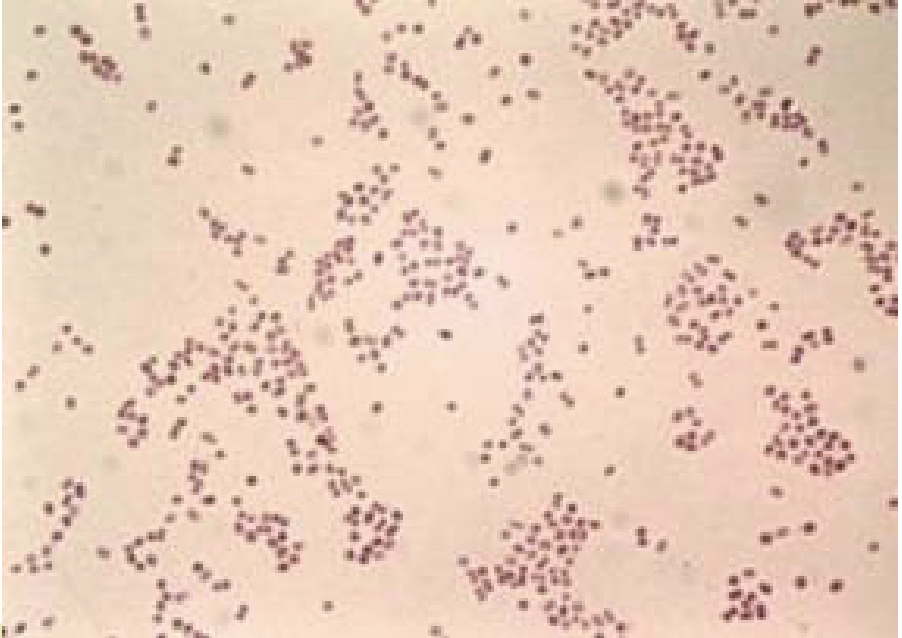
neisseria meningitidis
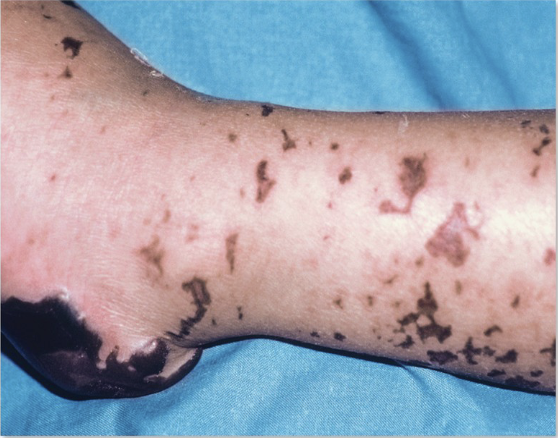
gram negative diplococci. responsible for 25% of all meningitis cases
transmission: droplet contact
virulence factors: capsule, endotoxin, IgA, protease
prevention: conjugated vaccine; ciprofloxacin, rifampin, or ceftriaxone used to protect contacts
Growth on modified Thayer-Martin (MTM) medium or chocolate agar in high CO2 environment. Oxidase positive.
Ceftriaxone is the first line antibiotic for treatment
Petechiae, meningococcemia, rapid decline
streptococcus pneumoniae
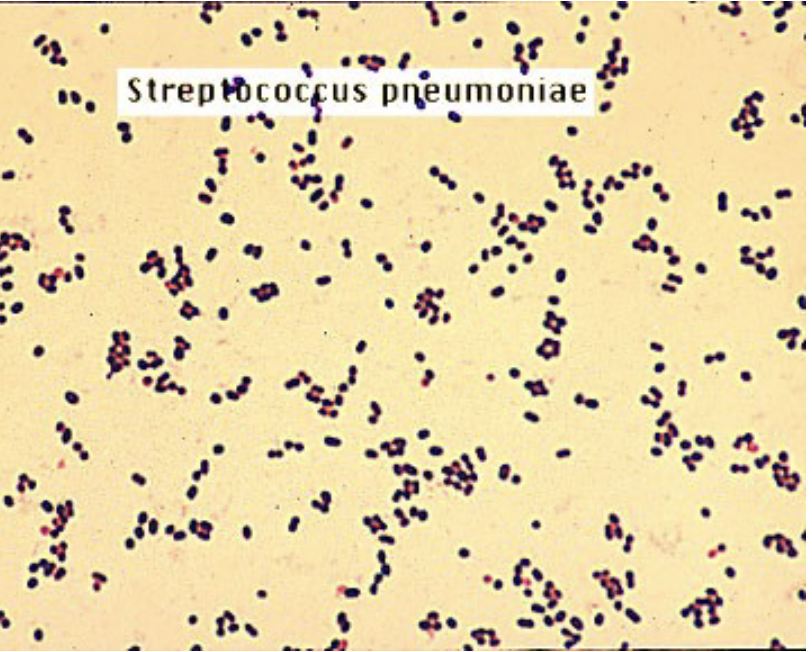
gram positive coccus
Also referred to as the pneumococcus
transmission: droplet contact
virulence factors: capsule, induction of apoptosis, hemolysin and hydrogen peroxide production
Resistant to penicillin, cephalosporins, and macrolide
antibiotics
causes majority of bacterial pneumonias, doesn't cause petechiae
treatment: vancomycin + ceftriaxone or cefotaxime
Haemophilus influenzae
Gram-negative coccobacillus known as "Hib"
Causes one of the most severe forms of meningitis in
humans
transmission: droplet contact
virulence factors: capsule
culture: on chocolate agar
prevention: Hib vaccine, ciprofloxacin, rifampin, or ceftriaxone
treatment: ceftriaxone
Listeria monocytogenes
Gram-positive, ranges in morphology from bacilli to long filaments in palisade formation. Does not produce capsules or endospores. Not fastidious, resistant to cold, heat, salt, pH extremes, and bile. Grows inside host cells, moves directly from an infected cell to an adjacent healthy cell. Transmission from vehicle (food). Prevention: cooking food, avoiding unpasteurized dairy products.
Listeriosis
Mild in healthy adults. Causes meningitis and septicemia in the
elderly,
immunocompromised, fetuses, and neonates. Bacterium can
cross the placenta and cause premature abortion and fetal death.
Associated with contaminated dairy products, poultry, and meat
A 45 year old man presents to his oncologist with a fever, headache and stiff neck. He has been undergoing chemotherapy for the last 4 months for advanced stage colon cancer. A lumbar puncture reveals numerous neutrophils and gram positive coccobacilli with filaments in the palisade formation. What is the disease? What is the causative agent?
Meningitis is the disease, the causative agent is listeria monocytogenes
Cryptococcus neoformans
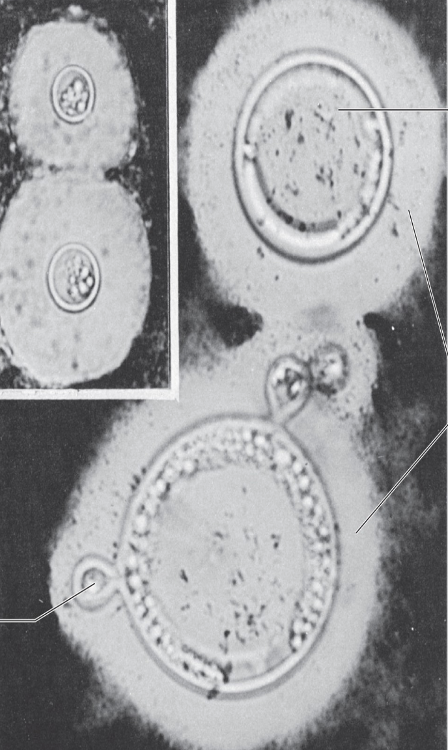
Fungus that causes more chronic meningitis with a gradual onset of symptoms. Transmission from vehicle (air, dust). Virulence factors are capsule, melanin production. Spherical to ovoid shape with a large capsule. Transmitted in bird droppings. In AIDS patients: fast onset and acute disease. Immediate treatment with amphotericin B and fluconazole.
Coccidioides immitis
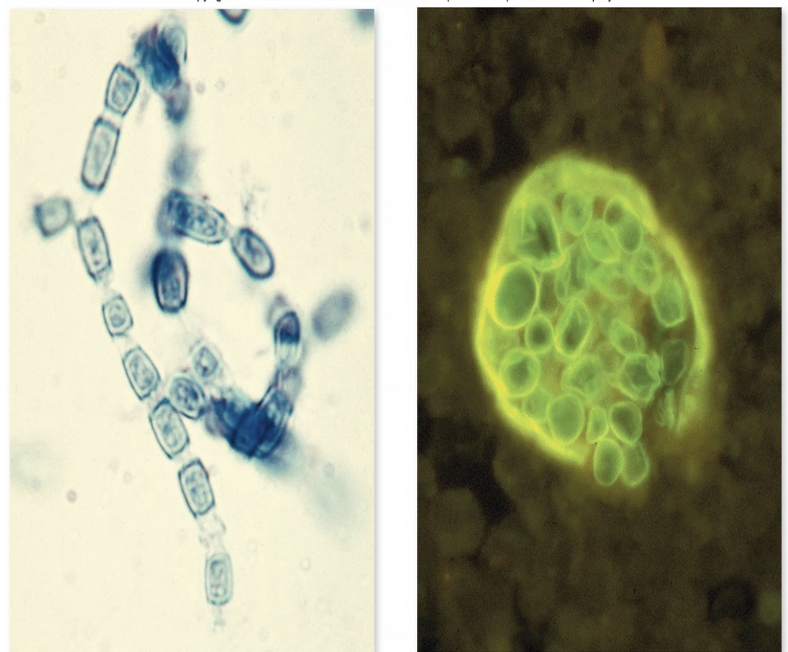
Fungi. 25°C: moist white to brown colony with abundant, branching, septate hyphae. 37 - 40°C: parasitic phase, small spherule. Occurs endemically in natural reservoirs. Commonly known as Valley Fever. Treatment: fluconazole or ampthotericin B.
viral meningitis
A wide variety of viruses can cause meningitis. Majority of cases in children. 90% caused by enteroviruses. HSV-2 is sometimes known to cause meningitis. HIV can manifest as meningitis as well. Generally milder than bacterial or fungal meningitis.
Aseptic meningitis
viral meningitis is assumed when a patient shows symptoms of meningitis but no bacteria or fungi are found in CSF.
Neonatal and Infant Meningitis
Usually the result of an infection transmitted by the mother in utero or during passage through the birth canal. As more premature babies survive, rates of neonatal meningitis increase. Mortality rates have significantly declined.
Streptococcus agalactiae
Lancefield group B streptococci. Colonizes 10 – 30% of female genital tracts. Most frequent cause of neonatal meningitis. Treated with IV Penicillin G sometimes supplemented with an aminoglycoside.
Neonatal K1 Escherichia coli
Gram negative. K1 strain second most common cause of neonatal meningitis. Most common in premature babies. 20% mortality rate, brain damage among those who survive. Usually transmitted by the mother’s birth canal
Cronobacter sakazakii
Gram negative. Found mainly in the environment and can survive very dry conditions. Implicated in outbreaks of neonatal and infant meningitis through contaminated powdered infant formula. Mortality rates can reach 40%.
A natural birth, premature infant in the the NICU has a poor prognosis. The child was born 1 month early and currently has a fever and is extremely irritable. Examination of the CSF reveals a gram negative bacillus. What is the disease? What is the causative agent?
Disease: neonatal meningitis
Causative agent: E. Coli
Encephalitis
inflammation of the brain. Because of the close association of the brain and spinal cord, infection of one structure may involve the other.
Amoebas cause meningoencephalitis: Naegleria fowleri and Acanthamoeba
Naegleria fowleri
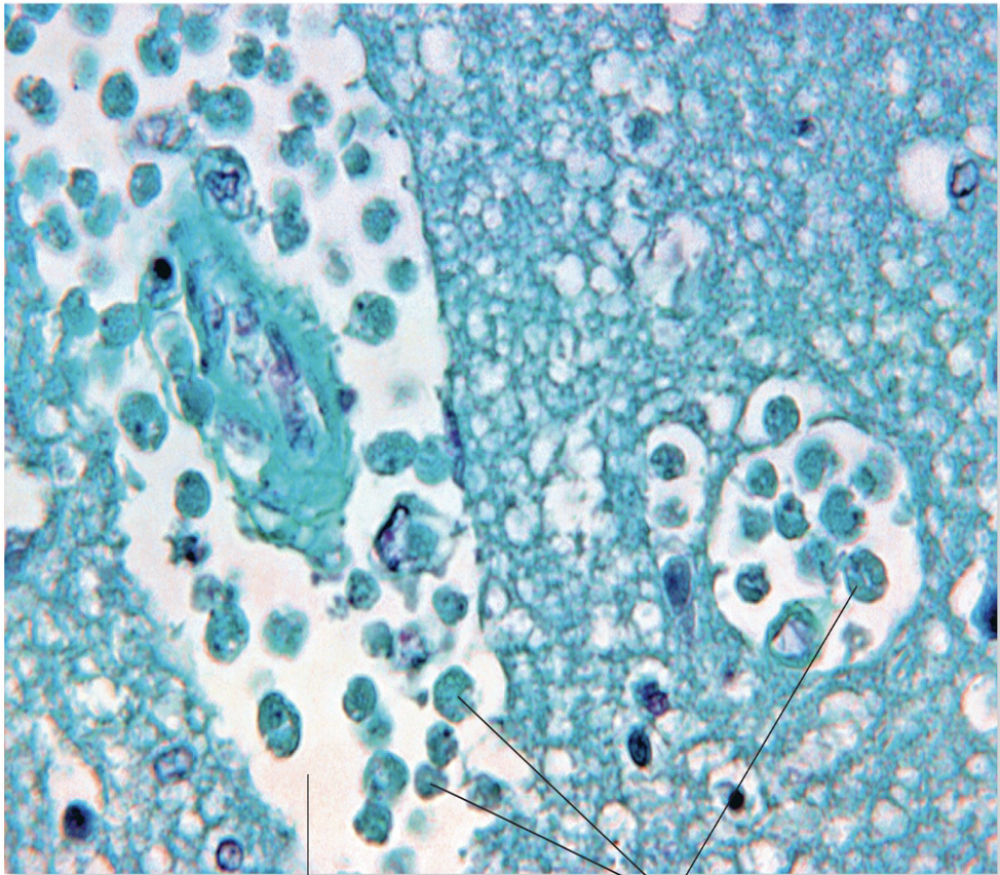
Amoeba. Amoebas forced into nasal passages utilize the olfactory
nerve to enter the brain. Enters the subarachnoid space causing
primary amoebic meningoencephalitis (PAM). Cases are rare, but the
disease
advances so rapidly that treatment is futile. Treatment
with pentamidine or sulfadiazine. Limit warm freshwater or untreated
tap water entering nasal passages.
Acanthamoeba
Large, amoeboid trophozoite with spiny pseudopods and a double-walled cyst. Invades broken skin, conjunctiva, lungs, and urogenital epithelia. Causes granulomatous amoebic meningoencephalitis (GAM). Course of infection is lengthier than PAM. 2 – 3% survival rate. Treatment: surgical excision of granulomas; pentamidine.
Acute Encephalitis
Almost always caused by viral infection. Causes behavior changes or confusion, decreased consciousness and seizures, and symptoms of meningitis. Treatment is usually with acyclovir.
Arboviruses
Viruses transmitted by arthropod vectors. Clustered in the tropics
and subtropics. Periodic epidemics in temperate zones. Most vectors
feed on the blood of hosts. Peak incidence usually during the late
spring and early
fall. Warm blooded hosts maintain the infection
during cold and dry seasons. Millions of infections per year,
thousands die. No satisfactory treatment for most arboviral infections.
Eastern equine, LaCrosse, St. Louis, Western equine, West nile, Venezuelan encephalitis's
Western Equine Encephalitis
Arbovirus. Occurs sporadically in the western US and Canada. Appears first in horses and later in humans. Mosquito vector emerges in the early summer. Extremely dangerous to infants and small children. Case fatality rate 3 – 7%.
Eastern Equine Encephalitis
Endemic to an area along the eastern coast of North America and Canada. Sporadic with occasional epidemics in humans and horses. High periods of rainfall favor mosquito populations, leading to increased incidence. Cases first appear in horses and caged birds. Vaccine exists and its use is strongly urged to eliminate the virus from its reservoir. Case fatality rate can reach 70%
California Encephalitis
Most often caused by California serotype viruses. Children are primary targets and exhibit mild, transient symptoms. Fatalities are rare.
California strain: Occurs occasionally in the western US and has little impact on humans
LaCrosse strain: Widely distributed in the eastern US and Canada and prevalent cause of viral encephalitis in North America.
St. Louis Encephalitis
Very common viral encephalitis. Cases occur in North and South America. Epidemics in the US occur in the Midwest and South. Asymptomatic infection is common. Peak activity occurs in the spring and summer.
An 8 year old boy from Maine is brought to the emergency room by his parents with complaints of fever, headache, stiff neck, malaise, nausea and vomiting that began 2 days ago. The boy appears disoriented and confused and has a seizure in the emergency department. Two weeks earlier in August, the patient had been on a summer camping trip in a rural wooded area of the county. The county health department has been trying to control the mosquito population in the area. What is the disease? What is the causative agent?
Disease: Encephalitis
Causative Agent: La Cross Virus
Herpes Simplex Virus
Herpes Simplex types I and II can cause encephalitis in newborns born to HSV-positive mothers. Virus is disseminated and progress is poor. Most common modes of transmission: vertical or reactivation of latent virus.
Subacute Encephalitis
Symptoms take longer to show up and are less striking. Toxoplasma, persistent measles infection, prions
Toxoplasma gondii
Flagellated parasite. Vehicle (meat) or fecal-oral. People with a history of this are more likely to display thrill-seeking behaviors and have slower reaction times. Primary reservoir is felines, both wild and domestic. Usually asymptomatic. Sore throat, lymph node enlargement, low grade fever. Chronic or subacute encephalitis in patients with immune suppression. 33% chance of the mother transmitting the infection to the fetus.
Measles Virus: Subacute Sclerosing Panencephalitis
“Slow virus infection”. Symptoms appear years after an initial measles episode. Caused by direct viral invasion of neural tissue. Unclear what factors lead to persistence of the virus in some people.
Prions
Proteinaceous infectious particles. Contain no genetic material.
Cause transmissible spongiform encephalopathies. Creutzfeldt-Jacob
disease (CJD). Gerstmann-Strussler-Scheinker disease. Kuru. Fatal
familial insomnia. Scrapie in sheep and goats. Bovine spongiform
encephalopathy (BSE). Normal protein in the brain (PRPC) is
transformed into a prion protein (PRPSC). Altered protein
spontaneously converts other PRPC
proteins into PRPSC proteins.
Accumulation of PRPSC proteins cause plaques and spongiform damage in
the brain.
Rabies
Slow, progressive zoonotic disease characterized by fatal encephalitis.
Furious rabies: Agitation, disorientation, seizures, twitching. Hydrophobia.
Dumb rabies: Patient is paralyzed, disoriented, stuporous
Both forms progress to a coma phase. Death results from cardiac or respiratory arrest
Rhabdoviridae lyssavirus, enveloped RNA virus
Polio
Acute enteroviral infection of the spinal cord. Can cause
neuromuscular
paralysis. Fever, headache, nausea, sore throat,
myalgia. Neurotropic: infiltrates the anterior horn of the motor
neurons of the spinal cord. Also attacks the spinal ganglia, cranial
nerves, and motor nuclei.
Polio sequelae
Paralytic disease: various degrees of flaccid paralysis of the
muscles of the legs, abdomen, back, intercostals, diaphragm, pectoral
girdle, and bladder
Bulbar poliomyelitis: brain stem, medulla,
and cranial nerves are affected Post-polio syndrome: progressive
muscle deterioration in 25 – 50% of patients decades after the initial infection
Tetanus
Clostridium tetani. Common resident of soil and GI tracts of animals. Gram-positive, endospore-forming rod.
Tetanospasmin
Binds to target sites on peripheral motor neurons on the spinal cord,
brain, and sympathetic nervous system
Blocks inhibition of muscle
contraction, causing muscles to contract uncontrollably, resulting in
spastic paralysis
Death results from paralysis of respiratory
muscles and respiratory arrest
Botulism
Intoxication: caused by an exotoxin. Associated with eating poorly
preserved foods. Toxin travels from the bloodstream to the
neuromuscular junctions of skeletal muscles. Prevents the release
of
acetylcholine, resulting in flaccid paralysis. Utilized by
doctors to treat
uncontrolled muscle spasms, migraine headaches,
and other conditions.
African Sleeping Sickness
Trypanosoma brucei. Hemoflagellate: lives on the blood and tissues of
the human host. Transmitted by the tsetse fly: T. brucei gambiense or
T. brucei rhodesiense. Intermittent fever, enlarged spleen, swollen
lymph
nodes, joint pain. Personality and behavioral changes.
Lassitude and sleep disturbances. Uncontrollable sleepiness during the
day,
sleeplessness at night. Muscle tremors, shuffling gait,
slurred speech,
seizures, local paralysis. Death results from
coma, secondary infections, and heart damage.